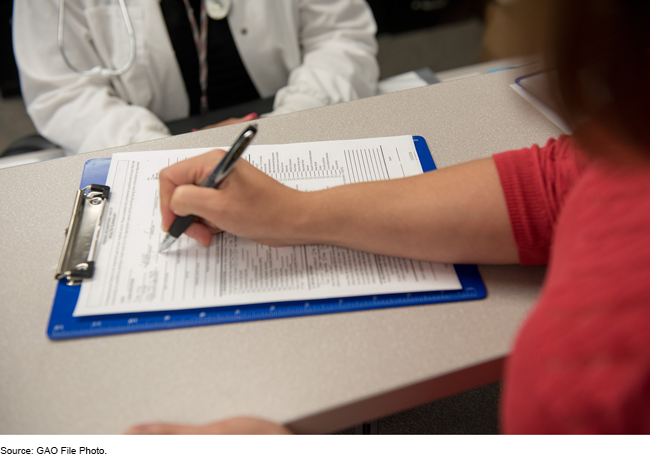Public Health: Federal Programs Provide Screening and Treatment for Breast and Cervical Cancer
Fast Facts
Tens of thousands of people die each year from breast or cervical cancer. Early screening, detection, and prompt treatment saves lives. The Centers for Disease Control and Prevention's Early Detection Program provides screening and diagnostic services to low-income and uninsured or underinsured people.
States may extend Medicaid to people who aren't otherwise eligible if they are screened under this program and require treatment.
Our analysis of CDC data found the number of people screened by the program decreased by about 46% from 2011-2018. CDC attributes the declines to improved screening access under the Affordable Care Act.

Highlights
What GAO Found
The Centers for Disease Control and Prevention (CDC) operates the National Breast and Cervical Cancer Early Detection Program (the Early Detection Program) to provide cancer screening and diagnostic services to people who are low-income and uninsured or underinsured. For those screened under the program who require treatment, the Breast and Cervical Cancer Prevention and Treatment Act of 2000 (the Treatment Act) allows states to extend Medicaid eligibility to individuals not otherwise eligible for Medicaid.
GAO analysis of CDC data show that the Early Detection Program screened 296,225 people in 2018, a decrease from 550,390 in 2011 (about 46 percent). The largest decrease occurred from 2013 to 2014 (see figure). According to a CDC-funded study, the number of people eligible for the Early Detection Program decreased from 2011 through 2017, by about 48 percent for breast cancer and about 49 percent for cervical cancer. CDC officials attributed these declines in screening and eligibility, in part, to improved access to screening under the Patient Protection and Affordable Care Act (PPACA). For example, PPACA required health plans to cover certain women's preventive health care with no cost sharing.
Number of People Screened by CDC's Early Detection Program, 2011-2018

GAO analysis of Centers for Medicare & Medicaid Services' (CMS) data found that, in 2019, 43,549 people were enrolled in Medicaid under the Treatment Act to receive treatment for breast or cervical cancer, a decrease from 50,219 in 2016 (13.3 percent). Thirty-seven states experienced a decrease in Medicaid enrollment under the Treatment Act during this time period, 13 states experienced an increase, and one state had no change. CMS officials noted that Medicaid expansion to adults with incomes at or below 133 percent of the federal poverty level under PPACA (the new adult group) is a key factor that contributed to these enrollment trends. CMS officials said that, in Medicaid expansion states, there were some people who previously would have enrolled in Medicaid based on eligibility under the Treatment Act who instead became eligible for Medicaid in the new adult group. The CMS data show that total enrollment under the Treatment Act in Medicaid expansion states decreased by 25.6 percent from 2016 to 2019. In contrast, total enrollment under the Treatment Act in non-expansion states increased by about 1 percent during this time period.
Why GAO Did This Study
According to the CDC, tens of thousands of people die each year from breast or cervical cancer. Early screening and detection, followed by prompt treatment, can improve outcomes and, ultimately, save lives. Federal programs, like CDC's Early Detection Program, are intended to improve access to these services.
GAO was asked to examine the implementation of the Early Detection Program and the states' use of Medicaid under the Treatment Act. This report provides information on the number of people who were 1) screened through the Early Detection Program and 2) enrolled in Medicaid under the Treatment Act.
GAO analyzed CDC data on the number of people screened by the Early Detection Program from calendar years 2011 through 2018—the most recent available. GAO also analyzed CMS Medicaid enrollment data from 2016 through 2019—the most recent available. Additionally, GAO reviewed a 2020 study funded by CDC that examines the number of people eligible for the Early Detection Program from 2011 through 2017. Finally, GAO interviewed CDC and CMS officials and reviewed relevant CDC and CMS documents.
For more information, contact John E. Dicken, (202) 512-7114, dickenj@gao.gov.
